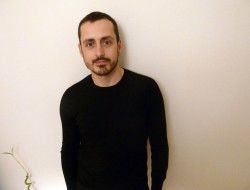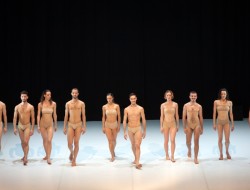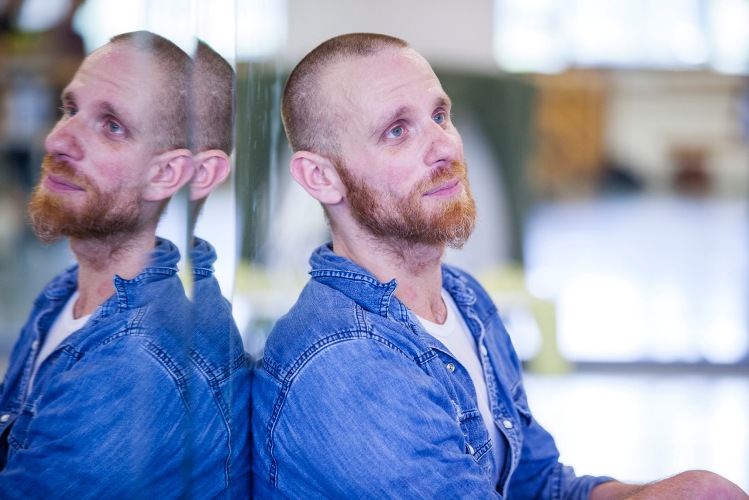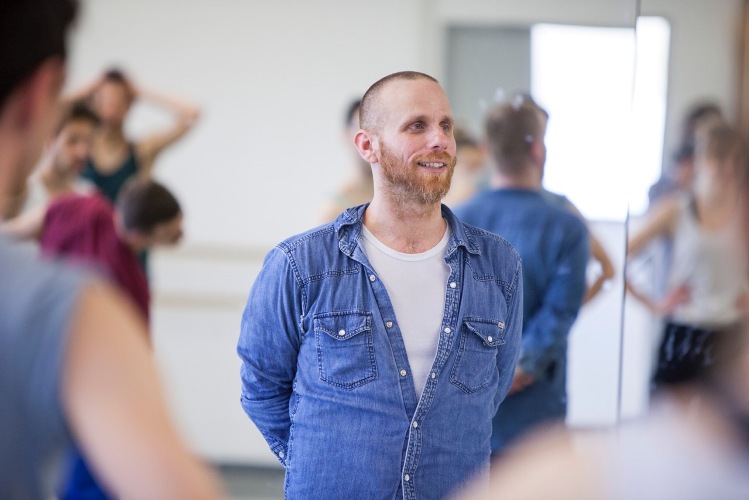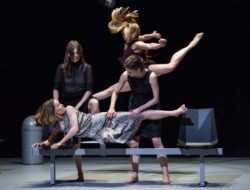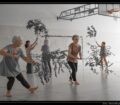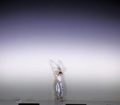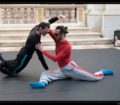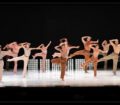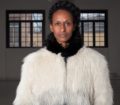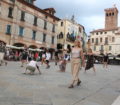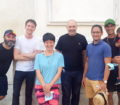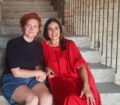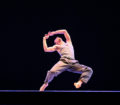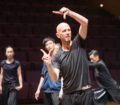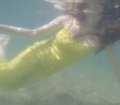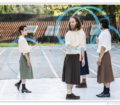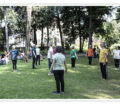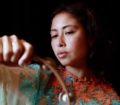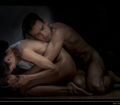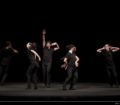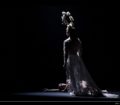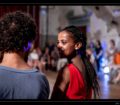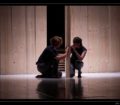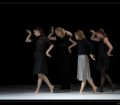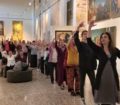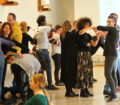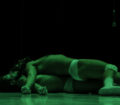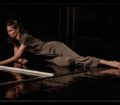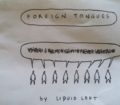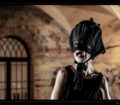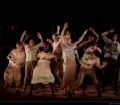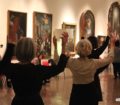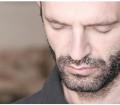July 26, 2016, Giselle, by Itamar Serussi and Chris Haring, performed by the Balletto di Roma Company, Teatro Remondini, Bassano del Grappa, Operaestate Festival
There is something candidly original in this first act of Giselle co-authored by Itamar Serussi.There is a rose-tinted purity in the sought-after uniformity of the costumes, minimal and transparent, identical for male and female. There is Eros, made flesh in the bodies of all. The nudity still arouses a raw malice. There is sensuality without vulgarity; simplicity without artifice, femininity without cliché. We see the carefreeness of love, experienced naturally, in the opening movements of Giselle, resembling the manoeuvres of a wild fawn. Hunting weaponry violently pierce the music and dance through shots fired.
Rage and anger is anticipated in the second act. There is all the waiting, the surprise and dismay swathed inside the unexpected chorus of silence of the stationary dancers, sitting on the stage, looking at the audience. In that long continuous embrace of the mother with Giselle’s body we feel all the tears never shed: a new secular reverence, completely female.
There is a reluctance for words and a fondness for pauses and punctuation in dance as in life for Itamar Serussi. Here is my interview.
Who is Giselle today?
I think everybody can be Giselle. We can all get hurt, we can all love, and fall in love, and we can all trip ourselves and make aware, make mistakes… I think that… the most interesting thing for me was to investigate this physically, bodily and imaginatively with the [Balletto di Roma] Company. It can also be very personal, relational… [In my Giselle] you can find something related to me, to my life, etc.
Itamar stops talking and smiles without adding anything more. He just avoids specifying any more about what’s related to his personal life. Then he recommences, hesitantly, as if he had opened a prohibited door into dangerous terrain which is better kept closed.
So, a little bit of the story, the narrative, the idea, the history of it today within the history we were able to find in the dancers as well.
Which recreation or reenactment of Giselle do you prefer? If there is one?
No, I don’t think so. I started to look at it but then I went to some point where I left it to stay, just in my own way, on my own path.
What about this co-authorship? Indeed, like Jean Coralli and Jules Perrot in the past, you and Chris Haring coauthored this Giselle: you curated the first act and Haring the second one. How did you proceed in creating your own choreography? How do your creations coexist?
We had some meetings and some exchanges on that way but our collaboration came more in the form of a dialogue: what we did was more about working together than creating together. It was very clear that I was taking care of the first act and that Chris Haring was responsible of the second act. We exchanged, we had some discussions before about some ideas, about the direction but we had a… “free relation”!
How would you define/describe your Giselle?
Well… we work with so many ideas… a lot of improvisation… how can I describe my Giselle…?
Itamar remains tacit. Then he smiles, looks at me and starts shyly moving his body, making dance steps.
Well, as a spectator I saw many Giselles, in each female dancer on the stage…
Yeah. I think she’s transforming. There is not just one Giselle character. There was also a moment when we tried to embody a multilayer of characters. I didn’t follow the complete narrative. It’s almost a ceremony for the dance of Giselle. It’s very physical. Of course, all my work is very physical but there is also a kind of extreme aesthetic. They almost transfer it with their colours and also they’re quite… “exposed”… in some… “aspects”!
Itamar smiles by alluding to the nacked-looking costumes the dancers wear while performing the first act.
Why?
Because I wanted to work with the tutu, with tulle. So, I wanted tutu! And then we tried it. It also makes things almost identical, the men and the women in a way, because it’s really… You see that they are women and you see that they are men but there is something that is immaterial on the body that is almost becoming unisex and that’s making it even more interesting, but it is not another completely covered element on the body. And it’s creating different strange colours on their bodies. And what I like is that it’s not provocative, it’s not pornography but it’s flesh, more… fleshy.
To me your Giselle is a little bit erotic. Isn’t?
Yeah. There is some… I think it’s maybe the interpretation but it’s my way to articulate movements. It’s very sensual my work. There’s narrative, like there is the choice of, it’s a woman who’s gonna die…
And what about the Balletto di Roma Company? How was it to work with them?
Challenging. It was an opportunity to explore new things with them, to go over their difficulties and their code. In fact they moved in certain set ways and with a certain volume and I didn’t just use the “ballet ballet” but I used my code. So, what we’ve done is to work with my information too. It was a good play but it was a long process, which required a lot of patience, a lot of accepting. I had to break them, to deconstruct their form and their understanding about what movement is. They are young but they have got a lot of a very organisational history which is very embodied in them. It is almost under their skin this dancing ballet. So, working with them was beautiful, very beautiful. There is something very special in them. I mean, when they suddenly started to understand what I was talking about and how to start being playful with it.
Itamar stops talking for a moment. After a few seconds he erupts in a summerising sentence.
‘Playful’ is also the word for my Giselle. Playful Giselle.
Interview by Anna Trevisan
GISELLE Choreography by Itamar Serussi and Chris Haring / Liquid Loft Concept development by Peggy Olislaegers Music by Adolphe Adam Sound Design by Richard van Kruysdijk, Andreas Berger Dancers: Balletto di Roma Company – Marcos Becerra, Francesco Saverio Cavaliere, Roberta De Simone, Siro Guglielmi, Fabio Novembrini, Luca Pannacci, Valentina Pierini, Eleonora Pifferi, Roberta Racis, Raffaele Scicchitano
LEGGI QUI IL TESTO IN ITALIANO:
26 Luglio 2016, Giselle, di Itamar Serussi and Chris Haring, con i danzatori del Balletto di Roma, Teatro Remondini, Bassano del Grappa, Operaestate Festival
C’è qualcosa di candidamente originario in questo primo atto di Giselle firmato da Itamar Serussi.
C’è una dolcezza pura e rosacea in questa voluta uniformità dei costumi di scena, minimali e trasparenti, identici per maschi e femmine. C’è Eros, incarnato nei corpi di tutti. C’è la nudità ancora vergine di malizia. C’è la sensualità senza volgarità; la semplicità senza l’artificio, la femminilità senza cliché. C’è la spensieratezza dell’amore, vissuto come naturale, nei movimenti iniziali di Giselle, che ricordano le movenze selvatiche di un cerbiatto. C’è la violenza delle armi da caccia che feriscono di spari la musica e la danza.
Ci sono una furia e una rabbia anticipatrici del secondo atto. Ci sono tutta l’attesa, la sorpresa, lo sgomento racchiusi nel sorprendente silenzio coreutico dei danzatori fermi, seduti sul proscenio, che guardano il pubblico. Ci sono tutte le lacrime mai piante in quel lungo continuato abbraccio della madre al corpo di Giselle: una Pietà laica, interamente femminile.
C’è una riluttanza alla parola e una predilezione per le pause e i segni di interpunzione nella danza e anche nella vita in Itamar Serussi. Qui la mia intervista.
Tags: Balletto di Roma, Chris Haring, Giselle, Itamar Serussi, Peggy Olislaegers, Roberto Casarotto

